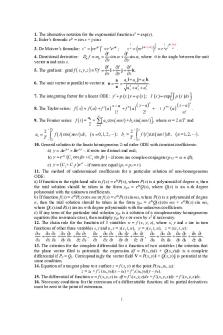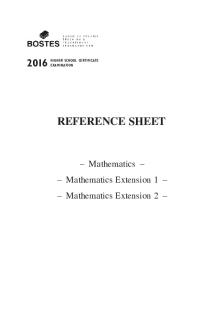Formula sheet - Summary Advanced Engineering Mathematics PDF

| Title | Formula sheet - Summary Advanced Engineering Mathematics |
|---|---|
| Author | Joe Sun |
| Course | Advanced Engineering Mathematics |
| Institution | University of Southern Queensland |
| Pages | 2 |
| File Size | 183.7 KB |
| File Type | |
| Total Downloads | 110 |
| Total Views | 147 |
Summary
Formula Sheet provided during final exam...
Description
1. The alternative notation for the exponential function ex = exp(x). 2. Euler’s formula: ejx = cos x + j sin x 3. De Moivre’s formulae: z n re j
1
1
1
j
2 k
z n re 2 n r n e n . r ne jn ; f f 4. Directional derivative: Dn f m cos sin , where is the angle between the unit x y vector n and axis x. f f f 5. The gradient: grad f x, y , z f i j k . x y z i ay j az k a a x 6. The unit vector n parallel to vector a: n . 2 2 2 a ax a y az n
j
k
7. The integrating factor for a linear ODE: y p x y q x ; I x exp p x dx . 8. The Taylor series: f x f a f a 9. The Fourier series: f t
2 an T
a0 2
x a x a f a 1! 2! 2
a cos n t b sin n t , n
n
a
x a n n!
.
where = 2 /T and
n 1
T 2
2 T
f t cos n t dt, n 0,1, 2,
T 2
T 2
T 2
10. General solution to the linear homogeneous 2-nd order ODE with constant coefficients: px p x a) y Ae 1 Be 2 – if roots are distinct and real; x b) y e C1 cos x C 2 sin x – if roots are complex-conjugate (p1,2 = ± i); rx c) y C 1 C 2x e – if roots are equal (p1 = p2 = r). 11. The method of undetermined coefficients for a particular solution of non-homogeneous ODE: a) If function in the right-hand side is f (x) = ekxP(x), where P(x) is a polynomial of degree n, then the trial solution should be taken in the form ypn = ekxQ(x), where Q(x) is an n-th degree polynomial with the unknown coefficients. b) If function f (x) = ekxP(x) cos mx or f (x) = ekxP(x) sin mx, where P(x) is a polynomial of degree n, then the trial solution should be taken in the form ypn = ekxQ(x) cos mx + ekxR(x) sin mx, where Q(x) and R(x) are an n-th degree polynomials with the unknown coefficients. c) If any term of the particular trial solution ypn is a solution of a complementary homogeneous equation (the resonance case), then multiply ypn by x or even by x2 if necessary. 12. The chain rule for the function of 3 variables w = f (x, y, z), where x, y and z are in turn functions of other three variables s, t and u, x = x(s, t, u), y = y(s, t, u), z = z(s, t, u): w w x w y w z w w x w y w z w w x w y w z , , . s x s y s z s t x t y t z t u x u y u z u 13. The criterion for the complete differential for a function of two variables (the criterion that the plane vector filed is potential): the expression df = P(x, y)dx + Q(x, y)dy is a complete differential if Py = Qx. Correspondingly the vector field V = P(x, y) i + Q(x, y) j is potential at the same condition. 14. Equation of a tangent plane to a surface z = f (x, y) at the point P(x0, y0, z0): z = z0 + f 'x (x0, y0)(x – x0) + f 'y (x0, y0)(y – y0). 15. The differential of function w = f (x, y, z) is: df = f 'x(x, y, z)dx + f 'y(x, y, z)dy + f 'z(x, y, z)dz. 16. Necessary conditions for the extremum of a differentiable function: all its partial derivatives must be zero at the point of extremum.
1
17. Sufficient conditions for the extremum. Find all second partial derivatives at the critical point: A = fxx(x0, y0), B = fxy(x0, y0), C = fyy(x0, y0) and calculate the discriminant: D = AC B2. - If D > 0 and A > 0 – then function z = f (x, y) has a local minimum at the critical point (x0, y0); - If D > 0 and A < 0 – then function z = f (x, y) has a local maximum at the critical point (x0, y0); - If D < 0 – then function z = f (x, y) has a saddle at the critical point (x0, y0); - If D = 0 – then the test is inconclusive. 18. Area of the plane figure can be calculated by means of a double integral over the domain bounded by the given curves A = 1dA. 19. The links between the Cartesian and polar coordinates: y 2 2 x r cos , y r sin ; r x y , atan . x 20. Conversion from the Cartesian to polar coordinates in double integrals: f x, y dxdy f r , rdrd .
21. Green’s theorem:
Q
P
F x, y dr P x, y dx Q x, y dy x y dxdy. C
C
22. The area of a domain via the contour integral: A F x, y dr C
curlF
z
dxdy
1dxdy.
23. The line integral of the first kind is: T
F x, y, z ds F t , t , t
,
0
where Γ is a continuous line in 3D space: r (t) = (t) i + (t) j + (t) k, where 0 ≤ t ≤ T, and scalar function F(x, y, z) is defined on 24. The line integral of the second kind is: A F x , y , z dr P x , y , z dx Q x , y , z dy R x , y , z dz
T
P t , t , t
0
where Γ is a continuous line in 3D space: r (t) = (t) i + (t) j + (t) k, where 0 ≤ t ≤ T, and F(x, y, z) is the vector field in 3D space: F(x, y, z) = P(x, y, z) i + Q(x, y, z) j + R(x, y, z) k. 25. The characteristic equation for eigenvalues: det (A ‒ I ) = 0; 26. Equation for eigenvectors of a matrix A: Av = v, where is a known eigenvalue. 27. Definition of the symmetric matrix AT = A. 28. The norm of n-component vector: v 12 22 . u11 u 2 2 u v 29. The angle between two vectors: cos u v u12 u22
.
30. Symmetric matrix: AT = A. Orthogonal matrix P: PT = P ‒1 or equivalently, if PPT = PTP = I. 31. sin 2 = 2 sin cos ; cos 2 = cos2 – sin2 ; 2sin2 = 1 – cos 2; 2cos2 = 1 + cos 2 . b
32. Integration by parts:
b
a
33.
a
2
b
u (x ) (x )dx u (x ) (x ) a (x )u (x )dx .
dx x 1 tan 1 ; 2 a a x
a
a
2
dx a x 1 ; ln 2 2a a x x
2
dx a x 2
2
sin 1
x x cos 1 . a a...
Similar Free PDFs

Engineering Formula Sheet
- 10 Pages

Engineering Formula Sheet
- 11 Pages

IED-Review Engineering Formula Sheet
- 10 Pages

Formula Sheet - Summary Physics
- 1 Pages

Summary Formula Sheet
- 27 Pages

Summary of Formula Sheet
- 13 Pages
Popular Institutions
- Tinajero National High School - Annex
- Politeknik Caltex Riau
- Yokohama City University
- SGT University
- University of Al-Qadisiyah
- Divine Word College of Vigan
- Techniek College Rotterdam
- Universidade de Santiago
- Universiti Teknologi MARA Cawangan Johor Kampus Pasir Gudang
- Poltekkes Kemenkes Yogyakarta
- Baguio City National High School
- Colegio san marcos
- preparatoria uno
- Centro de Bachillerato Tecnológico Industrial y de Servicios No. 107
- Dalian Maritime University
- Quang Trung Secondary School
- Colegio Tecnológico en Informática
- Corporación Regional de Educación Superior
- Grupo CEDVA
- Dar Al Uloom University
- Centro de Estudios Preuniversitarios de la Universidad Nacional de Ingeniería
- 上智大学
- Aakash International School, Nuna Majara
- San Felipe Neri Catholic School
- Kang Chiao International School - New Taipei City
- Misamis Occidental National High School
- Institución Educativa Escuela Normal Juan Ladrilleros
- Kolehiyo ng Pantukan
- Batanes State College
- Instituto Continental
- Sekolah Menengah Kejuruan Kesehatan Kaltara (Tarakan)
- Colegio de La Inmaculada Concepcion - Cebu









